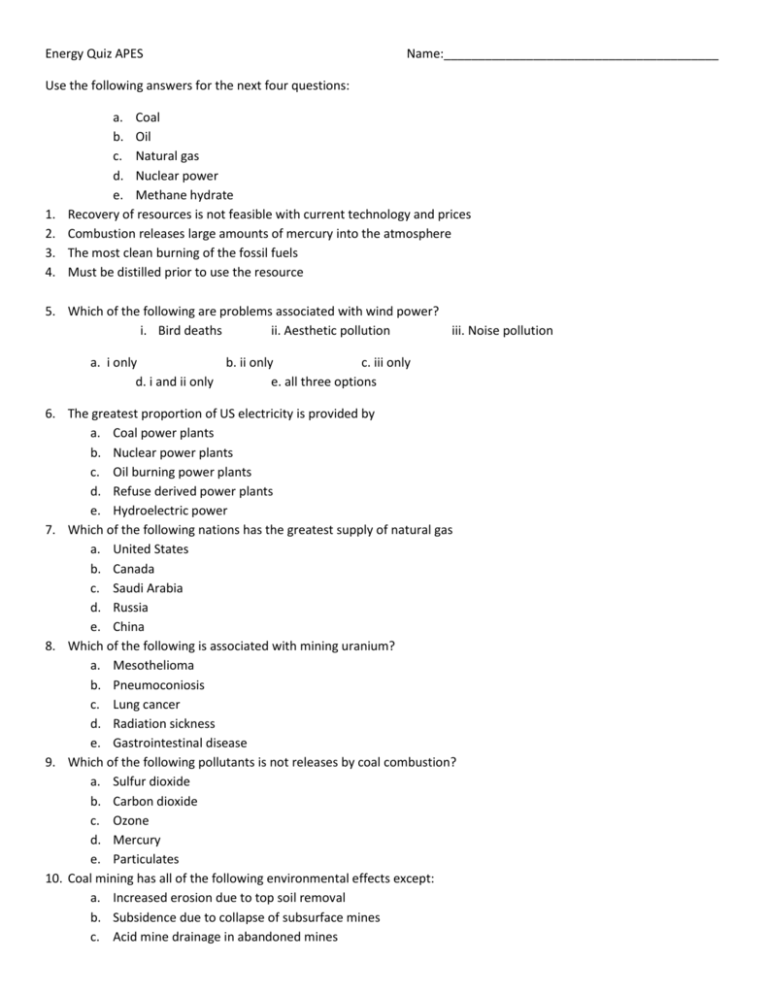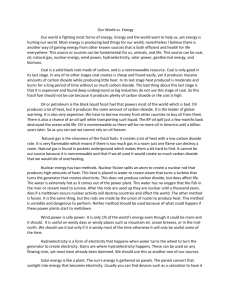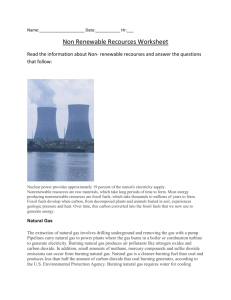Energy Quiz APES
advertisement

Energy Quiz APES Name:________________________________________ Use the following answers for the next four questions: 1. 2. 3. 4. a. Coal b. Oil c. Natural gas d. Nuclear power e. Methane hydrate Recovery of resources is not feasible with current technology and prices Combustion releases large amounts of mercury into the atmosphere The most clean burning of the fossil fuels Must be distilled prior to use the resource 5. Which of the following are problems associated with wind power? i. Bird deaths ii. Aesthetic pollution iii. Noise pollution a. i only b. ii only c. iii only d. i and ii only e. all three options 6. The greatest proportion of US electricity is provided by a. Coal power plants b. Nuclear power plants c. Oil burning power plants d. Refuse derived power plants e. Hydroelectric power 7. Which of the following nations has the greatest supply of natural gas a. United States b. Canada c. Saudi Arabia d. Russia e. China 8. Which of the following is associated with mining uranium? a. Mesothelioma b. Pneumoconiosis c. Lung cancer d. Radiation sickness e. Gastrointestinal disease 9. Which of the following pollutants is not releases by coal combustion? a. Sulfur dioxide b. Carbon dioxide c. Ozone d. Mercury e. Particulates 10. Coal mining has all of the following environmental effects except: a. Increased erosion due to top soil removal b. Subsidence due to collapse of subsurface mines c. Acid mine drainage in abandoned mines 11. 12. 13. 14. 15. 16. 17. 18. 19. 20. d. Transport of coal results in damage to aquatic systems if tankers are damaged e. Increased habitat disruption due to deforestation All of the following structures in a pressurized water nuclear power plant are correctly paired with its function EXECPT? a. Primary water circuit cools the fission reaction b. Secondary water circuit is heated and spins the turbine to generate electricity c. Water in the cooling tower is used to cool the primary water circuit d. Moderator absorbs neutrons to stop the fission reaction e. Containment vessel encompasses the electrical generator to prevent explosion Which of the following is not an argument against drilling in the Arctic National Wildlife Refuge? a. Growing season is very short making it difficult for the ecosystem to recover b. Permafrost makes soil formation very difficult, resulting in a long succession of time c. Area is a calving ground for caribou d. High levels of biodiversity will allow the ecosystem to recover quickly e. Cold temperatures decrease the rate of nutrient cycling Which of the following are associated with commercial active solar generation? I. little land use and habitat disruption II. mining silicates for PV cells results in erosion III. Thermal pollution from cooling power plants a. I only b. II only c. III only d. I and II e. I, II, and III All of the following methods will reduce NOx emissions from gasoline combustion except a. Catalytic converters in automobiles b. Controlling the combustion temperatures c. Switch fuel to ethanol or ethanol mixed fuel d. Switch to hybrid vehicle e. Decrease the release of ozone auto emissions The fissionable component of nuclear fuel in a conventional nuclear power plant is a. Uranium-238 b. Uranium-235 c. Uranium-234 d. Plutonium-239 e. Radon-222 Use the following answers for the next four questions: a. Geothermal energy b. Passive solar power c. Active solar power d. Hydroelectric power e. Biomass power Uses the heat produced by natural decay of radioactive isotopes in the earth’s crust to heat water to spin turbines Exemplified by photovoltaic cells Examples include dung, peat, and ethanol Has the greatest net energy of all of the alternative energy resources 21. If your laptop computer uses 50 watts per hour and you use it for three hours per day, how much will the electricity cost to run the computer for one year if your utility charges $0.08 per kilowatt (kWh) hour? a. $10.46 b. $8.52 c. $5.00 d. $4.38 e. $2.98 22. Which of the following forms of energy is a renewable resource? a. Synthetic oil b. Breeder fission c. Biomass d. Oil shale e. Synthetic natural gas 23. Which of the forms of energy has low, short-term availability? a. Solar energy b. Synthetic oil derived from coal c. Nuclear energy d. Coal e. Petroleum 24. Which of the following alternatives would NOT lead to a sustainable energy future? a. Phase out nuclear power subsidies b. Create policies to encourage governments to purchase renewable energy devices c. Assess penalties or taxes on continues use of coal and oil d. Decrease fuel-efficiency for cars, appliances, and HVAC systems e. Create tax incentives for independent power producers 25. The lowest average generating cost (cents per kWh) comes from what energy source? a. Large hydroelectric facilities b. Geothermal c. Nuclear d. Solar photovoltaic e. Coal 26. The fastest renewable energy resource today is a. Nuclear b. Coal c. Wind d. Large-scale hydroelectric e. Geothermal 27. The least-efficient renewable energy resource today is a. Steam turbine b. Fuel cell c. Fluorescent light d. Incandescent light e. Internal combustion engine 28. Which is NOT an advantage of using nuclear fusion? a. Abundant fuel supply b. No generation of weapons-grade material c. No air pollution d. No high-level nuclear waste e. All are advantages 29. Only about 10% of the potential energy of gasoline is used in powering an automobile. The remaining energy is lost as a low-quality heat. This is an example of the a. First law of thermodynamics b. Second law of thermodynamics c. Law of conservation of energy d. First law of efficiency e. Law of supply and demand 30. Which of the following is not a unit of power? a. BTU b. Horsepower c. Kilowatt d. Joule e. All are units of power 31. If you were designing a house in the US, you lived in a cold climate, and you wanted it to be as energy efficient as possible, you would place large windows to capture solar energy on which side of the house? a. North b. South c. East d. West e. It makes no difference which side Free-Response: A large natural gas-fired electrical power facility produces 15 million kilowatt-hours of electricity each day it operates. The power plant requires an input of 13,000 BTU’s of heat to produce 1 kilowatt-hour of electricity. One cubic foot of natural gas supplies 1,000 BTU’s of heat energy. a. Showing all steps in your calculations determine the: i. BTUs of heat needed to generate the electricity produced by the power plant in 2 hours. ii. Cubic feet of natural gas consumed by the power plant each year iii. Cubic feet of carbon dioxide gas released by the power plant each day. Assume that methane combusts with oxygen to produce only carbon dioxide and water vapor and that the pressures and temperatures are kept constant. iv. Gross profit per year for the power company. The power company is able to sell electricity at $50 per 500kWh. They pay a wholesale price of $5.00 per 1,000 cubic feet of natural gas. b. What environmental effect might the production of electricity through the burning of natural gas pose? c. Describe two other methods of producing electricity, and provide technological, economic, and environmental pros and cons for each method discussed. Key; 1. E 2. A 3. C 4. B 5. E 6. A 7. D 8. C 9. C 10. D 11. B 12. D 13. B 14. E 15. B 16. A 17. C 18. E 19. B 20. D 21. C 22. E 23. D 24. A 25. C 26. D 27. E 28. B 29. D 30. B Free Response: a. i.) 24hr/1d x 1.5*107kWh/24 hr x 13000BTU/1kWh = 1.95 *1011 BTU per day ii.) 1.95*1011 BTU/day x 1ft3/1000 x 1d/24 hr = 8.13*106 ft3 natural gas/hr iii.) Ch4 (g) + 2O2 (g) CO2 (g) +2H2O (g). If everything is a gas and, if temperature and pressure are constant, then the coefficients can represent volume. Therefore, we could say that 1 ft. cubed of methane gas combines with 2 ft cubed of oxygen gas to produce 1 ft cubed of carbon dioxide and 2 ft cubed of water vapor. 98.13*106 ft3 Ch4 /hr x 1ft3 CO2/1 ft3 CH4 x 24hr/1day = 1.95*108 ft 3 CO2 per day Income: 1.57 kWh/day x 365 d/yr x $50/500kWh = $5.48*108 ($548 million) per year Costs that the power company spends on natural gas: 8.36*106ft3 natural gas/hr x 24hr/day x 365day/yr x $5.00/1,000ft.3 natural gas = $3.66 *108 *$366 million) per year Gross profit: ($5.48*108) – ($3.66*108) = $1.82*108 ($182 million) b. An environmental effect that results from the burning of natural gas to produce electricity is the production of CO2 – greenhouse gas. As a greenhouse gas, the carbon dioxide gas molecules absorbs radiant energy reflected from Earth’s surface and re-radiate this energy as a long-wave infrared radiation back to Earth. This trapping of the Earth’s heat has serious environmental consequences in terms of its effect on global weather patterns, local climate conditions, and the glaciers and polar ice caps. Other environmental effects produced by burning natural gas include the production of hydrogen sulfide gas(H2S) and sulfur dioxide gas (SO2) as production by-products. Sulfur dioxide when combine with atmospheric water vapor produces what is known as acid rain. Acid rain has serious environmental effects primarily on aquatic organisms in lower tropic levels and on the reproduction of developing aquatic organisms. Hydrogen sulfide has serious environmental effects as a toxic pollutant and respiratory irritant. Leakage of Ch4 during processing adds methane to the atmosphere, which has more deleterious effects as a greenhouse gas than does carbon dioxide. Drilling platforms to extract natural ag, the production of contaminated wastewater and brine, the possibility of land subsidence, and the disruption of wildlife and habitat refuges are other deleterious side effects of using natural gas. However, these negative side effects have less environmental impacts than does using other forms of fossil fuels. c. Other methods of producing electricity include burning coal and using dams. The advantages of using coal are that it is plentiful and relatively inexpensive. Currently, the world used 4 billion metric tons of coal per year. At this rate, the world has enough coal to last for the next 200 years. Drawbacks to using coal include that current extraction methods are environmentally damaging to the land and natural habitat and are potentially dangerous to miners. Burning coal also releases radioactive particles and mercury into the air. Carbon dioxide produced from burning coal adds to the problem of global warming. The nitrogen oxides released add to the problem of acids precipitation. Dam creates large flooded areas that destroy natural habitats and disrupt the lives of the people who inhabit the area. The collection of sediment by the dam, the loss of this valuable sediment downstream and thereby making the land less productive, the obstructions that dams cause to migrating fish populations and the aesthetic loss of a wild river are detractors of hydroelectric power. On the positive side, hydroelectric power does not significantly add to global pollution.










